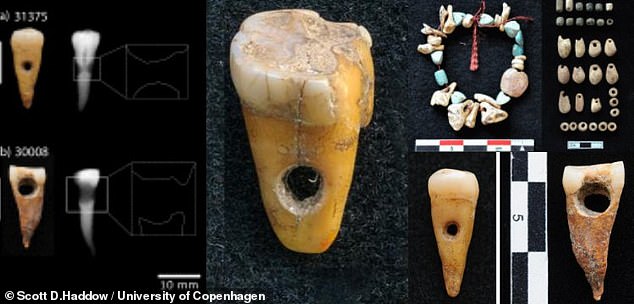Bizarre Stone Age jewellery made from human teeth found in the ancient Turkish city
Researchers conducting excavations at the Neolithic city of Çatalhöyük have found a grisly type of artefact never previously documented in the ancient Near East: jewellery made out of human teeth.
As Kristina Killgrove reports for Forbes, Çatalhöyük, a Unesco World Heritage Site located in south-central Anatolia (now Turkey), was active between 7,100 and 5,500 B.C. Archaeologists have worked in the area since the 1960s, but the three 8,500-year-old teeth—unearthed between 2013 and 2015—are the first of their kind found at the site. The scientists’ research is detailed in the Journal of Archaeological Science: Reports.
According to a press release, the teeth appear to have been intentionally drilled. Microscopic analysis revealed wear patterns consistent with use as a jewellery bead on two of the altered molars, but an assessment of the third tooth proved inconclusive.
“Not only had the two teeth been drilled with a conically shaped microdrill similar to those used for creating the vast amounts of beads from animal bone and stone that we have found at the site,” says lead author Scott Haddow of the University of Copenhagen, “but they also showed signs of wear corresponding to extensive use as ornaments in a necklace or bracelet.”
Per Gizmodo’s George Dvorsky, Dvorsky, similar accessories have been documented at European sites dating to the Upper Palaeolithic, Mesolithic and Neolithic periods, but never before in the Near East.
The study suggests the teeth-turned-beads were taken from two different individuals. Signs of wear place the original molar owners’ ages between 30 and 50. Since the teeth do not show signs of disease, the archaeologists suspect they were extracted from the humans’ skulls after death rather than lost naturally due to dental problems.
Archaeologists have uncovered nearly 700 graves at Çatalhöyük since 1993. Some of these burials contained beads and jewellery made from animal bones and teeth, but none featuring adornments from human teeth have been found to date. Crucially, writes Dvorsky, the molars at the centre of the new study weren’t discovered in a burial setting.

So, who did these teeth originally belong to, and why were they worn as jewellery?
“[B]ecause of the rarity of the find, we find it very unlikely that these modified human teeth were used solely for aesthetic purposes,” says Haddow in the release. “… Rather, [they] carried profound symbolic meaning for the people who wore them.”
According to Haddow, there were plenty of human remains—including teeth—available to Çatalhöyük’s residents. Previous discoveries at the site indicate the ancient civilization engaged in secondary burial practices, defined by Killgrove as the “post-mortem manipulation of the dead,” or extended burial rituals designed to honour one’s ancestors and keep the deceased in the realm of the living.

As documented on Haddow’s personal blog, skulls covered with plaster to resemble living people, their eye sockets decorated with cowrie shells and other ornaments, represent just one example of secondary burial rites practised at Çatalhöyük.
Still, modified teeth jewellery has “never been found before in the Near East,” Haddow tells Killgrove, “which is surprising given the well-documented observation of other burial practices such as plastered skulls.”
For now, the molars’ origins and significance remain largely unclear.
“Perhaps these human teeth pendants were related to specific—and rare—ritual taboos?” says Haddow in the release. “Or perhaps we should look to the identity of the two individuals from whom the teeth were extracted for an explanation.”
The archaeologist adds, “[G]iven the small sample size, the ultimate meaning of the human teeth pendants will remain elusive until new findings at Çatalhöyük or elsewhere in the Near East can help us better contextualize the meaning of these human teeth artefacts.”
